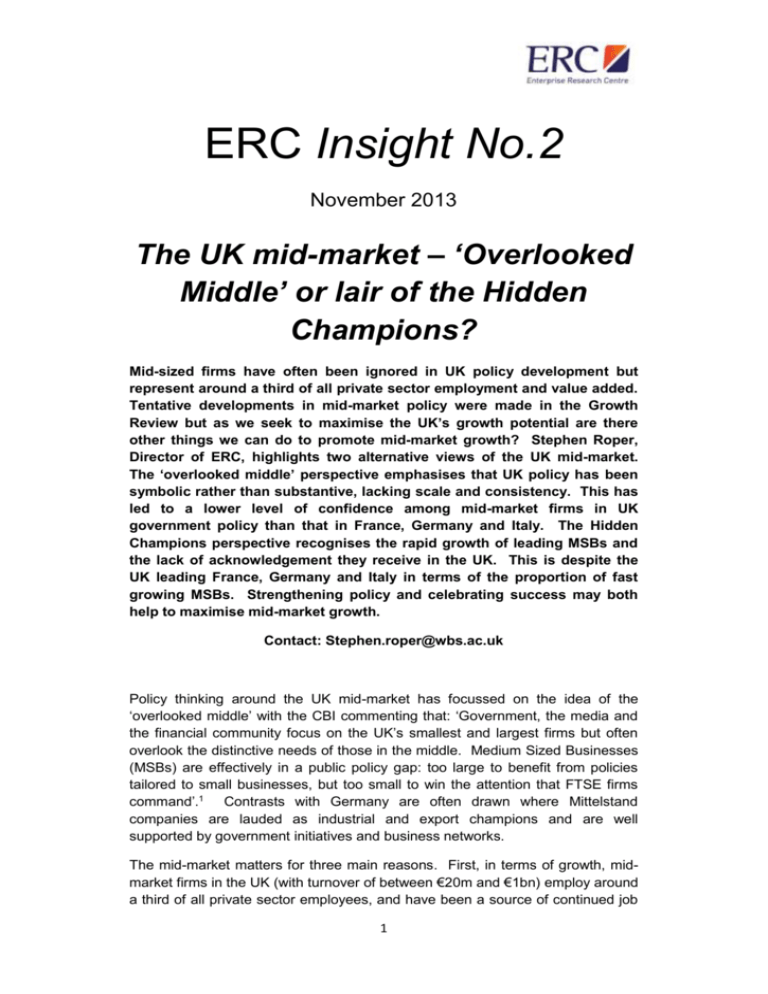Insight (PDF) - Enterprise Research Centre
advertisement

ERC Insight No.2 November 2013 The UK mid-market – ‘Overlooked Middle’ or lair of the Hidden Champions? Mid-sized firms have often been ignored in UK policy development but represent around a third of all private sector employment and value added. Tentative developments in mid-market policy were made in the Growth Review but as we seek to maximise the UK’s growth potential are there other things we can do to promote mid-market growth? Stephen Roper, Director of ERC, highlights two alternative views of the UK mid-market. The ‘overlooked middle’ perspective emphasises that UK policy has been symbolic rather than substantive, lacking scale and consistency. This has led to a lower level of confidence among mid-market firms in UK government policy than that in France, Germany and Italy. The Hidden Champions perspective recognises the rapid growth of leading MSBs and the lack of acknowledgement they receive in the UK. This is despite the UK leading France, Germany and Italy in terms of the proportion of fast growing MSBs. Strengthening policy and celebrating success may both help to maximise mid-market growth. Contact: Stephen.roper@wbs.ac.uk Policy thinking around the UK mid-market has focussed on the idea of the ‘overlooked middle’ with the CBI commenting that: ‘Government, the media and the financial community focus on the UK’s smallest and largest firms but often overlook the distinctive needs of those in the middle. Medium Sized Businesses (MSBs) are effectively in a public policy gap: too large to benefit from policies tailored to small businesses, but too small to win the attention that FTSE firms command’.1 Contrasts with Germany are often drawn where Mittelstand companies are lauded as industrial and export champions and are well supported by government initiatives and business networks. The mid-market matters for three main reasons. First, in terms of growth, midmarket firms in the UK (with turnover of between €20m and €1bn) employ around a third of all private sector employees, and have been a source of continued job 1 creation throughout the recession.2 However, other evidence suggests the negative observation of lower average turnover per employee in UK MSBs compared to those in other European economies,3 and that UK MSBs are underrepresented in the top 10 per cent of the growth distribution of UK firms.4 Second, it has been argued that as mid-sized firms account for a larger proportion of private sector employment in Northern and Central regions of the UK, a vibrant and growing mid-market provides a potential mechanism for regional rebalancing.5 Third, as manufacturing firms are more important in the mid-market than in the economy as a whole, growing the mid-market also provides a potential mechanism for sectoral rebalancing towards manufacturing and export-led growth.6 Re-thinking the UK mid-market The characterisation of the UK mid-market as the ‘overlooked middle’ tells only part of the story, and under-estimates the vibrancy and drive of many mid-market companies. Another view – emerging from research on MSBs around the world sees the mid-market as the lair of the ‘Hidden Champions’.7 Hidden Champions are those mid-sized firms which are market leaders in their field but which are not large enough to have become household names. Often privately held or family-owned, these are mature firms which adopt ‘super nichist’ strategies focussing on building market leadership within a narrowly defined but global market niche. This allows the development of highly focussed core competencies which helps to overcome diseconomies of scale due to firm size. Academic accounts identify five key attributes of the Hidden Champions: First, they combine strategy focussed on technological leadership within a niche market with selling globally. Second, they have a detailed understanding of customer values and use this effectively to inform their product and service offerings. Third, they balance technologically-driven product/service developments and those driven by customer demands by frequently engaging engineering and technical staff in customer communications. Fourth, they exhibit strong ‘self- reliance’ with an emphasis on ‘make’ rather than ‘buy’ in terms of both technology and components. Finally, many Hidden Champions are key local employers in small towns or villages, creating a mutual inter-dependence between the business and its employees and other local SMEs through local supply chains. The evidence also suggests that this type of strategy does deliver in terms of sustained performance. One study following a group of over 200 German Hidden Champions through the decade prior to the recent recession suggested they maintained a growth rate more than three times the German average over the next decade.8 2 We know relatively little about the UK’s Hidden Champion businesses but what is clear is that in terms of growth performance the UK mid-market seems to be performing well compared to other EU mid-markets. Recent survey evidence, for example, suggests that during 2012-13, 17 per cent of UK mid-market firms achieved growth rates of 10 per cent or more compared to 13 per cent in Germany, 11 per cent in France and 13 per cent in Italy. Supporting mid-market growth; celebrating the UK’s Hidden Champions The Coalition’s Growth Review did include some specific policy initiatives designed to support mid-market firms (188-193) including: Export support and finance – new funding was provided in the Plan for Growth for UK Trade and Investment to engage with 500 new MSB clients and expand the group of dedicated MSB International Trade and Export Finance Advisers in each region9. Barriers remain, however, for UK mid-market firms seeking to take advantage of emerging export markets. Around 1:5 UK mid-market firms (and around 1:3 of those seeking to increase export to emerging markets), for example, highlight ‘a lack of local knowledge contacts in new market(s) of interest’ as the main barrier they faced in increasing exports. At a national level, this is equivalent to around 5-6,000 MSBs which continue to face significant barriers to exporting. Supply chains and resource efficiency - schemes such as the Waste and Resources Action Programme (WRAP) have a target of supporting 200 MSBs by end 201410. In contrast to the scale of this initiative, recent survey evidence suggested around 42 per cent of UK mid-market companies (around 12,000 companies) see cost barriers as their main barrier to growth. Local support for MSBs – the Plan for Growth included eight Local Enterprise Partnerships (LEPs) which developed pathfinder projects to support MSBs. Progress has been made with these initiatives but it is not clear whether similar initiatives are going to be extended to the other 31 LEPs and the majority of MSBs. Business school relationships with MSBs were examined by a UK Task Force which published its report in 2012. ‘While the Task Force has uncovered many examples of effective business school engagement with MSBs, there is much more that both sides can do to foster stronger, more sustainable relationships … We are failing to make the most of our world class business schools’.11 In terms of the Growth Review this action is now ‘Complete’. More difficult, however, is to assess the extent to which the Task Force report and its recommendations have led to changes in MSB-business school relationships. 3 Each of these MSB initiatives is of value. In terms of scale, consistency and breadth, however, they fall well short of a comprehensive policy framework for maximising the growth potential of the UK’s MSBs. The export measures highlighted, for example, will help only 1:10 of those MSBs facing export barriers, and similar scale issues apply to each of the other measures. More broadly the limitations of current policy frameworks are reflected in the views of MSBs themselves. Less than a third of UK mid-market firms - 30 per cent – agree that ‘government has appropriate measures in place to support economic growth’ compared to 41-44 per cent of mid-market firms in France, Germany and Italy. These firms tend not to be those in the hidden champions group, however. Policy development aside there may also be substantial benefits from increasing the visibility of the UK’s Hidden Champions and more broadly firms in the UK Mittelstand. Possibilities include the development of a ‘Mid-market Economic Forum’ to work alongside the ‘Small Business Economic Forum’, or indeed the appointment of a minister with specific responsibility for championing support for the mid-market. Key measures to develop the profile of mid-sized companies might also include the development of specific awards for mid-sized companies to celebrate their export or innovation achievements. High profile awards such as the Queen’s Awards for Enterprise, for example, could acknowledge the scale of award winners, either by developing separate categories for companies of different sizes, or simply acknowledging that firms belong to the group of UK MSBs. Finally, it is worth acknowledging that the evidence base on the drivers of competitiveness and growth in UK mid-market firms remains limited. Working with our partners, the ERC plans further work in this area and we would welcome thoughts or comments which would inform our activities. Another dimension of this issue is the value of developing a stronger evidence base relating to the UK mid-market and its international competitor. This is a question of research priorities. Notes: 1 CBI (2011). Future champions: Unlocking growth in the UK's mid-sized businesses. London, Confederation of British Industry, p. 4. 2 Malshe, A. and S. Roper (2012). Leading from the middle: the untold story of British Business London GE Capital. Roper, S. and A. Malshe (2013). The Mighty Middle - Growth and opportunity in the UK's mid-market. London, GE Capital/Warwick Business School. 3 Cebulla, A (2011), for example, estimated turnover per employee in UK MSBs in 2010 at €221,300 compared to: Finland (2009), €290,200; France (2007), 4 €290,100; Germany (2009), €268,400; and, Sweden (2009), €301,400. Midsized businesses in Finland, France, Germany, Sweden and the UK - General Statistics, National Institute of Economic and Social Research. 4 Hart, M. (2011). BIS MSB Research: Note on Regressions, Economics and Strategy Group, Aston Business School. 5 CBI (2011). Future champions: Unlocking growth in the UK's mid-sized businesses. London, Confederation of British Industry. 6 Livesey, F. and J. Thompson (2013). Making at home, owning abroad London, RSA/Lloyds Bank Group. 7 Simon, H. (1996). Hidden champions - lessons from 500 of the world's best unknown companies. Boston, MA, Harvard Business School Press. 8 Venohr, B. and K. E. Mayer (2007). "The German miracle keeps running: How Gemany's hidden champions stay ahead in the global economy " mimeo. 9 HMT (2013) Plan for growth implementation update – March 2013, p. 33. 10 HMT (2013) Plan for growth implementation update – March 2013, p. 34. Department for Business Innovation and Skills (2012) ‘Business School MSB Task Force’, p. 5. 11 5







